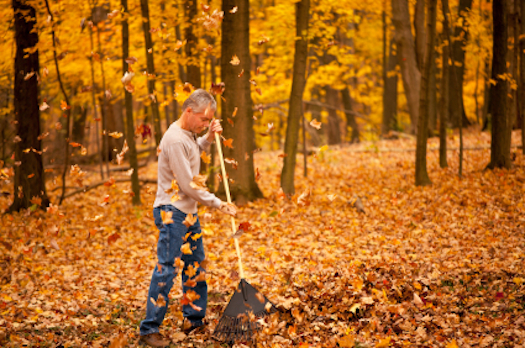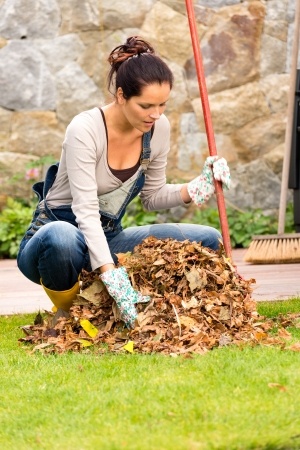Prevent Leaf Raking Injuries

Tid Bits of Info
- “Fit the rake to your body, not your body to the rake!”
- Warm up prior to beginning your day of raking leaves.
- Stand more erect when you rake. Bending too far can injure your low back.
- Try to prepare for the upcoming “raking season” by performing the exercises listed several times per week.
- If you get injured, you should seek the advice of a Physical Therapist to help you recover from the symptoms and return to your pre-injury functional status.
After a long hard day of raking leaves, you look forward to a refreshing sleep, but the pain in your back keeps you awake all hours of the night. Leaf raking injuries and associated pain can cause many a sleepless night and may even cost you a trip to the Doctor or Physical Therapist. Lack of preparation coupled with poor leaf raking techniques increases the likelihood of pain and injury.
Before tackling that leaf-covered lawn why not follow a few simple guidelines that can help prepare your body for the work at hand and reduce the chances of injury. Several steps to keep in mind when raking your lawn include starting with a proper warm up, choosing the right tool, dressing appropriately, using proper techniques and pacing yourself.
Starting with a Proper Warm up
Raking your lawn is quite physical and involves walking, twisting, bending, squatting, kneeling and getting your body into some awkward positions throughout the day. You might want to consider performing a lite cardiovascular workout prior to beginning your leaf-raking task. In fact, you might want to begin preparing couple weeks in advance, then do a warm up before raking that includes cardio-workout and stretching to help prepare the joints and soft tissues of your body for the job in the yard. If you prepare properly, there is a good chance that you will not get injured when you “take on” the task of raking the leaves from your yard.
Exercising a Few Weeks in Advance
The following exercises can help get your body geared up for the strenuous activity of raking leaves. Start doing this a few weeks ahead of time.
Strength: Planks, Side Planks, Standing Rotations, Biceps curls, Lat Pull Downs, Pull Aparts with Theraband, Squats and Lunges.
Stretches: Hamstring, trunk rotations, Knees to chest, Achilles stretches, and Shoulder stretches.
Warm up on the Day of Leaf Raking
It’s leaf-raking day. Begin your day with a short cardiovascular exercise (walk, ride a bike or a short jog). This will be a good way to begin to “warm-up” the joints and soft tissues of the body. The blood will leave the gut and be transported to the extremities. You can perform one set of 15 repetitions of each of the strengthening exercises and 2-3 repetitions of each stretch. Hold the stretch for 20-30 seconds. Once you begin to rake, start slowly and allow your body to get used to the raking motion. Pick up the pace accordingly and don’t forget that it is not a race to the finish.
Choosing the Right Tool
Rakes come in all sizes and shapes. The new ergonomic rakes (bent handles and possibly an adjustable rake-head) are not good for everyone. They are designed to prevent excessive bending, but you have to determine what rake handle “fits” your body the best. Plastic rake-heads are lighter and can still do a great job of gathering the leaves. Wide rakes (up to 36 inches) can speed up the job, but they also might cause you to use more force to pull the rake through the pile of leaves. The standard rake size might be better.
Dressing Appropriately
Wear shoes that will keep you from slipping. Many of the leaves might have gotten wet from the night dew or a recent rainfall. If it is sunny, use sunscreen. Wear clothing that is appropriate for the temperature that you are working in, but will also protect you from ticks, spiders and other bugs found in your yard and leaves. They may bite and could transmit diseases.
Using Proper Leaf Raking Techniques
 Stand upright with a slight bend at the waist. Your feet should be “staggered or a scissor stance” for stability. This enables you to extend the rake and pull it back towards you with the least amount torque on your back. Your knees should be slightly bent. Raking is usually a dominant hand chore with the dominant side doing most of the pulling, but try to switch sides and change your feet position often. Each foot should get the opportunity to be the lead foot and each hand can be placed near the top of the rake and perform most of the pulling action. Don’t overextend your reach because this will force you to flex at the waist and flex your shoulders excessively to extend the rake forward. Don’t try to pull too hard or too many leaves at one time. This will cause the spine to twist excessively and might cause damage or an injury.
Stand upright with a slight bend at the waist. Your feet should be “staggered or a scissor stance” for stability. This enables you to extend the rake and pull it back towards you with the least amount torque on your back. Your knees should be slightly bent. Raking is usually a dominant hand chore with the dominant side doing most of the pulling, but try to switch sides and change your feet position often. Each foot should get the opportunity to be the lead foot and each hand can be placed near the top of the rake and perform most of the pulling action. Don’t overextend your reach because this will force you to flex at the waist and flex your shoulders excessively to extend the rake forward. Don’t try to pull too hard or too many leaves at one time. This will cause the spine to twist excessively and might cause damage or an injury.
Pacing Yourself
Most likely, your day in the yard raking leaves will be just that…the entire day. Go at a good pace. Take frequent breaks. Raking the leaves into several small piles allows you to move less weight and never a huge pile of leaves at one time.
Raking leaves is a common activity that most everyone has performed at some time in their lifetime. It can be excessively taxing to your musculoskeletal system if you are not properly prepared to rake. Take the time to get ready and you will probably be able to complete the raking job and not injure yourself.
























